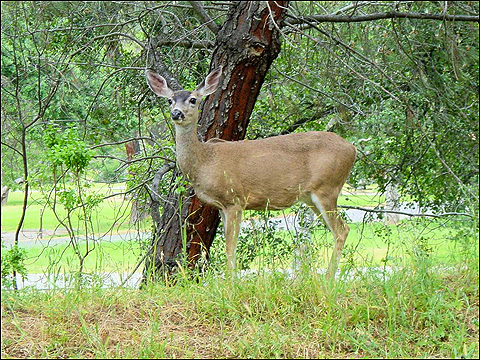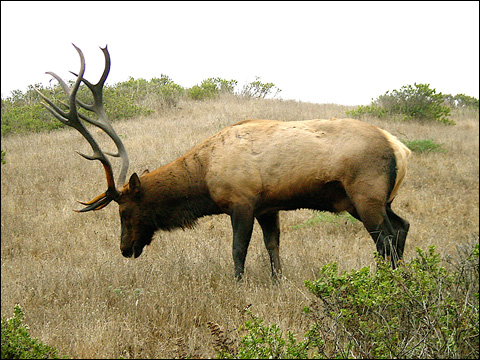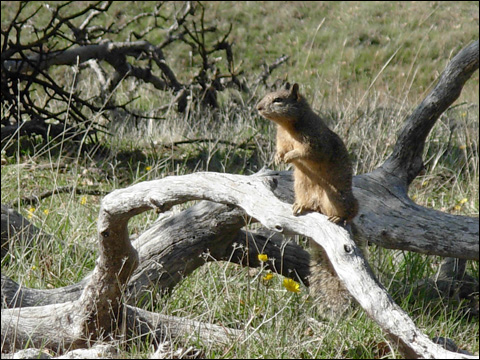
ANIMAL RESOURCES
Index of Animal food resources listed by Heizer & Elsasser 1980:101-108
These animals are listed in Heizer & Elsasser’s work as important to California’s Indians. Information gleaned elsewhere is included under each animal listed.
A note about cooking: Throughout California, meat, sometimes fish or shellfish and vegetables, were often cooked in an earth oven. This was a pit in the ground heated with coals or heated stones. The pit was layered with leaves and with the food to be cooked. More leaves were added to protect the food. Then the oven was covered with earth and the heat was allowed to steam the covered food. Earth ovens were documented by Harrington as being used by the Ohlone and the Pomo (Jacknis 2004:199). If this method of cooking doesn’t sound appetizing to the modern reader, consider what tourists pay to enjoy food cooked by essentially the same method at a traditional Hawaiian luau!
Cooking directly on coals, on heated rocks, or in hot ashes and stone boiling food in baskets were other methods employed by native people to cook foods (Jacknis 2004:55). These methods were foreign to European settlers, and often viewed as uncivilized. Nowadays we consider barbecue an art and Louisiana blackened redfish a delicacy.
Black tail deer (Odocoileus hemionus columbianus): This is the subspecies of mule deer that inhabits the coast ranges of the Ohlone Peoples. These animals are smaller than their inland relatives, the mule deer, and they tend to live most of their lives close to where they are born. In October, breeding season coincides with acorn drop and these deer gather in larger groups (Ingles 1947:425- 428). During this season they lose some of their usual cautiousness.
As recounted by Mayfield during his time with the Yokuts, deer skin disguises, complete with head, antler and hide, were used to help hunters approach deer closely . . . . as close as 20 feet. To do this, they closely imitated the behavior of a deer, kept themselves downwind and disguised their human scent. A hunter's mental and physical preparations for a stalking-type hunt included undergoing a sweat and bathing prior to even handling his bow (Thomas Jefferson Mayfield, 1929:80-81). Or, as the hunter might say, he did these things because that is what the deer wanted if it was to allow itself to be shot (Heizer & Elsasser 1980:211).
As chronicled by the first Spanish to arrive, two or three deer were commonly given as gifts by the Ohlone (Bean 1994:190 from Costansó 1769/1910:65-67).
Deer provided tools (antler wedges, bone awls, scapular saws) and hides for clothing (Bean 1994:263).

Black tail deer
Tule elk (Cervus nannodes): The first Spanish soldiers of 1769 describe elk and made note of their mule-like hoof prints (Bean 1994:190 from Costansó 1769/1910:65-67), (Newton and Bennett 1972:11). Elk no longer live abundantly in the Bay Area or Monterey, but they have been reintroduced to protected areas. In Early October, they can be heard making a high pitched call as the males gather and vie over a group of females (Ingles 1947: 424). Elk remains are found in Ohlone shellmounds as were antler wedges (Bean 1994:263).

Bull elk
Pronghorn antelope (Antilocapra americana): Our only American antelope, pronghorns primarily inhabited open valleys. These animals are designed superbly for running. They have been clocked at 38 miles per hour, making them the fastest North American mammal. They live and travel in herds (Ingles 1947:434). They no longer inhabit the regions around San Francisco and Monterey Bay, but they were here at the time of the arrival of Spanish Missionaries, and 2 or 3 were often given to the Spanish as gifts from the Ohlone (Bean, 1994:190 from Costansó 1769/1910:65-67). Fossil records for this family dates back to the Miocine period in North America (Ingles 1947:434).
Black bear (Euarctos americanus): Though called a black bear, its coat can be black, brown, or cinnamon. These animals are omnivores, feeding primarily on fruit, nuts, roots, grasses, insects, small rodents and fish. They occasionally take larger mammals. If sufficiently fat, these animals become dormant (hibernates) during the winter regardless of the temperature. If they are not sufficiently fat, they may remain active during the winter (Ingles 1947:353-354).
Grizzly bear (Ursus chelan): This bear no longer exists in California, and its subspecies, the California Grizzly (Ursus Californicus) is extinct (Ingles 1947:354). Prior to the profound changes brought to California by Missionization and later by the Gold Rush, this large, often carnivorous bear was common in California. It was capable of hunting elk or salmon, and was the top predator. Though it ate other animals, this bear is omnivorous. Grizzlies were considered dangerous and these bears sometimes killed people. An early Spanish explorer noted the absence of Ohlone villages in the Berkeley area, and attributed this to the large numbers of grizzly bears in the area (Bean 1994:14 from Fagas diary). Its bones are seen in shellmounds of the Ohlone (Bean 1994:263).
Bears were not eaten by some California Indian groups, however, in 1769, Spanish explorers shot a grizzly near Monterey and traded the meat with the Ohlone (Bean 1994:15-16). This suggests the meat had value and was eaten locally.
Beechy ground squirrel (Ostospermophilis variegates): Lives in colonies with elaborate underground tunnels. These squirrels are diurnal (day active) animals, a fact that makes hunting easier for human predators as well as hawks and eagles (Ingles 1947:174). The Choinumne (Yokut) plugged tributary burrows and lit fires over main burrows, forcing smoke down the holes with a skin-covered basket-fan. Then they would plug the burrows and wait. An hour or so later they would unplug the holes and pull from the entrance the squirrels overcome by smoke. This style of hunting secured large numbers of squirrels (Mayfield 1929:73-74). Several plants are listed as used by the Ohlone to drive squirrels from their burrows (See Other Uses of Plants).

Beechy ground squirrel
Western gray squirrel (Sciurus griseus): These squirrels feed primarily on acorn, and they spend much of their time in the trees, rather than on the ground. When acorn is available in the fall, it is gathered and buried singly by squirrels. The squirrel returns to them by smell (Ingles 1947:196). Modern squirrel hunters consider this game animal exceptionally good eating (author).
Rabbits and Hares: Though modern Americans living in cities may regard rabbits as pets, they are food animals throughout much of the world. Rabbits and hares provide part of an important food web for predators (secondary consumers), including humans.
Black-tailed hare or Jackrabbit (Lepus californicus): This is a hare rather than a true rabbit. They can breed year round and their young are born fully furred, wide-eyed and soon ready to run. With up to 7 young per litter, a single female can give birth to 14 or more young per year. These animals do not make burrows (Ingles 1947:147). Mayfield recounts rabbit drives among the Choinumne (Yokut) where 200 or more rabbits might be taken in one afternoon. A net 30 feet (sometimes far longer) was set up. People lined up in two wings at each end of the net, moving like a great gate. Closing in, they drove the rabbits between the two lines. Many escaped, but throwing sticks and clubs dispatched many animals as they dodged about. Often they ran toward an apparent opening in the line of humans, only to find themselves stopped by the net. The skins were cut into long strips and fashioned into warm blankets (Mayfield 1929:77-99). Rabbit remains are found in Ohlone shellmounds (Bean 1994:263).
Cottontail rabbits: Probably the Audobon cottontail (Sylvilagus audobonii) and the Brush rabbit (Sylvilagus bachmani). The cottontails give birth to a litter of hairless young whose eyes are closed at birth. Cottontails do not make burrows, but hide their young in a nest on the ground. They reproduce several times in a season (Ingles 1947:149). Their remains are found in Ohlone shellmounds (Bean 1994:263).
.
White-throated wood rat (Neotoma albigula) (Ingles 1947:267-268): Its remains are noted in Ohlone shell middens (Bean 1994:263).
ANIMAL RESOURCES LIVING WITHIN OHLONE TERRITORY (not listed by Heizer & Elsasser)
Absent from Heizer’s list of resource animals are a myriad of small rodents and birds which were probably utilized by the Ohlone (author).
Shorebirds: Willets, curlews, sandpipers, oystercatchers, wimbrels, dowichers, rails and yellowlegs are but a few of the species inhabiting the bay wetlands. Many of these were later touted as excellent eating by the San Franciscans arriving during the Gold Rush. In fact, market hunters of the time nearly extinguished them. The remains of curlews and herons are noted in Ohlone shellmounds (Bean 1994:263). Also, identified in Ohlone shellmounds were marbled godwits, long-billed curlews, whimbrels and smaller shorebirds such as sandpipers (Broughton, Jack at University of Utah http://www.physorg.com/news10821.html).
California quail (Callipepla californica): Quail spend much of their time on the ground, usually only flying when danger threatens them. Although this bird usually flocks together in a “covey”, they break up into breeding pairs during nesting season. Females produce up to 14 eggs (usually in a nest on the ground) and may rear two sets of young in good years. The chicks hatch ready to feed and can follow their parents on the ground (Kaufman 1996:160). These birds have a feathered plume on their heads. This little plume was prized by Pomo basket weavers as a decorative addition to fancy baskets (Powers 1976:187). The bird is prized today as a game bird, and was a food resource for Native Peoples as well (author). In the San Juaquin Valley, the Choinumne (Yokut) caught quail in a wicker basket trap. A low fence guided running birds into the trap (Mayfield 1929:75). Its bones are noted in Ohlone shellmounds (Bean 1994:263).

California quail
Waterfowl (geese, ducks and swans): The San Francisco Bay, tidal marshes and associated Sacramento delta are part of the winter migratory route for ducks and geese. Prior to modern landfill projects, this salt marsh/wetland habitat was far more extensive. Father Crespi’s notes, taken during the Spanish explorations of 1772, mention they were given life-like stuffed goose decoys used by the Ohlone for hunting geese (Bean 1994:10, 15). Neighboring Yokuts hunted geese with nets attached to willow poles (Mayfield 1929:75). An Ohlone net (use unknown) is documented by Father Juan Crespi in 1772 (Bean 1994:17). It is apparent the Ohlone knew and used netting techniques and that they hunted geese . . . . but use of netting by the Ohlone to catch waterfowl is still speculative.
It is proposed that winter village sites were large and centralized near the bay. Winter bayside village sites allowed hunters to take advantage of excellent waterfowl hunting opportunities along tidal lands (Bean 1994:48). These winter camps were probably occupied (by some of the Ohlone population) year round (Jacknis 2004:183). The author notes winter habitation would also time mussel gathering to avoid seasonal “red tide” shellfish poisoning.
Cormorant (Phalacrocorax spp.): These birds nest in rocky cliffs. Its eggs, as well as the eggs of many birds, were collected when locally available as noted in the July 1774 diary of Father Serra (Bean 1984:184 from Serra 1748-84/1955-56:2:142).
Gray fox (Urocyon cinereoargnteus): This small fox prefers brushy areas. It feeds primarily on insects, small rodents, birds and berries (Ingles 1947:347-348). Illustrations of Ohlone men by Louis Choris show arrow quivers made from what appears to be a gray fox pelt. Their remains are found in Ohlone shellmounds (Bean 1994:263).
Coyote (Canis latrans): It is adaptable and lives in many different California environments. It is our largest member of the dog family. They feed on rabbits, hares, ground squirrels, mice, rats and insects (Ingles 1947:346-347). This animal figures prominently in origin stories of California’s Native Peoples. Most groups did not eat this animal (Heizer & Elsasser 1980:101). Their remains are found in Ohlone shellmounds (Bean 1994:263).
Bobcat (Lynx rufus): This short tailed cat preys primarily on rodents and rabbits and prefers rocky and brushy country. It also eats birds to a lesser extent (Ingles 1947:392). This animal has a fine winter coat, spotted and streaked with black. Their remains are found in Ohlone shellmounds (Bean 1994:263).
Mountain lion (Felis concolor): This animal is also known as a puma, cougar or panther. Its primary food is deer, though it does take smaller animals (Ingles 1947:390). This is not an easy animal to hunt and probably was not commonly pursued by the Ohlone. Indeed, these animals might well mistake a man in a deer hunting disguise to be a meal. Their remains are found in Ohlone shellmounds (Bean 1994:263).
Raccoon (Procon lotor): These animals are nocturnal (night active) and weigh 10 to 15 pounds. They are omnivorous, feeding on fruit and acorn as well as crayfish, fish, turtles, eggs, frogs and insects (Ingles 1947:355-356). They can accumulate large deposits of fat, which makes them a high calorie meal for predators like mountain lions and humans. Their remains are found in Ohlone shellmounds (Bean 1994:263).
River and sea otters, and sea mammals: Ohlone women were reported to wear sea otter capes like a cloak (Heizer & Elsasser 1980:157 from Cardero 1791). The Ohlone were known to travel on San Francisco Bay in tule balsas (reed boats) (Heizer & Elsasser 1980:71), however I have not found documentation of seal hunting by the Ohlone. Stellar sea lions, harbor seals, elephant seals and California sea lions frequented San Francisco Bay and/or the coastal waters south to Monterey. Sea mammal teeth are present in Ohlone archeological sites (Emeryville artifacts, disc 4, http://emeryville.wli.net/gallery/gallery5/disk12/disk_12.htm), but it is not clear that these were hunted or that they were important food resources. Sea mammal hunting was generally a less important food resource in Central California (Jacknis 2004:195).
Ohlone archaeological remains include mammal bones of: Elk, deer, longtail weasel, bobcat, striped skunk, spotted skunk, badger, raccoon, grizzly bear, pronghorn, tule elk, deer, gray fox, wolf, coyote, wood rat, squirrel, gopher, mole, jackrabbit and cottontail rabbit (Bean 1994:263).
Archaeological remains also include bird bones of: Ducks, geese, quail, flicker, barn owl, hawks, falcons, crows, band-tail pigeons, herons and curlews (Bean 1994:263).
Emeryville shell mounds shows evidence of bay and ocean travel by Ohlone in the remains of birds from island breeding species. In particular, the remains of island nesting cormorant chicks and sea ducks only found in open water and on the outer coast. Also, identified were marbled godwits, long-billed curlews, whimbrels and smaller shorebirds, such as sandpipers (Broughton, Jack at University of Utah, http://www.physorg.com/news10821.html). A study by H. Howard published in 1929 analyzed bird bones at Emeryville. His report gave evidence supporting year-round occupation of village sites (Bennyhoff 2010:website).
Junipero Serra’s notes recount chicks the size of a chicken from a fish-eating seabird were caught and eaten by the Ohlone near Carmel (Bean 1994:1840).
Archaeological remains also include reptile bones of the Western pond turtle (Bean 1994:263).
INSECTS
No insects are reported as food sources for the Ohlone. Some neighboring groups use insects as food resource when seasonally plentiful. The insects used by neighboring groups are listed below.
“Army worms”: A moth caterpillar (Homoncocnemis fortis) was gathered by the Pomo only in years when abundant in early summer. It feeds on ash trees, denuding it of leaves. Without shade it drops to the ground as the day warms. Trenches and pits are dug below trees and each is surrounded with a little wall of sand. Once the caterpillar falls in the pit, it is unable to crawl up over the sand to escape. They were then dropped in a basket of cold water to kill them, then boiled or roasted in hot ashes before eating (Jacknis 2004:203-204), (Heizer & Elsasser 1980:103-107). I found no documentation that this was an Ohlone food.
Grasshoppers: Unnamed California Indian cultures are reported to drive grasshoppers into a deep hole using fire (Heizer & Elsasser 1980:103-107). Powers notes the Konkau were driving them into pits, or netting them. They then dried and powdered them for later use (Powers 1996:431). I found no documentation that this was an Ohlone food.
Bees: The larva of native bees were utilized by some groups including the Yokuts (Heizer & Elsasser 1980:103-107). “Native bees” were not honeybees. Honeybees are an introduced species (author). I found no documentation that this was an Ohlone food.
![]()
Photographs by Susan Labiste. All photo rights reserved.
We hope the information on the PrimitiveWays website is both instructional and enjoyable. Understand that no warranty or guarantee is included. We expect adults to act responsibly and children to be supervised by a responsible adult. If you use the information on this site to create your own projects or if you try techniques described on PrimitiveWays, behave in accordance with applicable laws, and think about the sustainability of natural resources. Using tools or techniques described on PrimitiveWays can be dangerous with exposure to heavy, sharp or pointed objects, fire, stone tools and hazards present in outdoor settings. Without proper care and caution, or if done incorrectly, there is a risk of property damage, personal injury or even death. So, be advised: Anyone using any information provided on the PrimitiveWays website assumes responsibility for using proper care and caution to protect property, the life, health and safety of himself or herself and all others. He or she expressly assumes all risk of harm or damage to all persons or property proximately caused by the use of this information.
© PrimitiveWays 2016